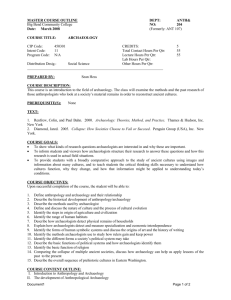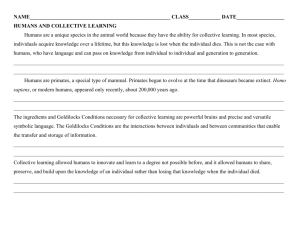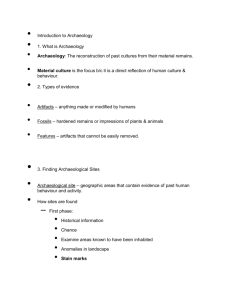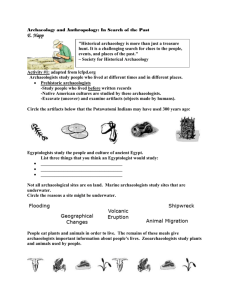Research Paper - austinrobertgrant.com
advertisement
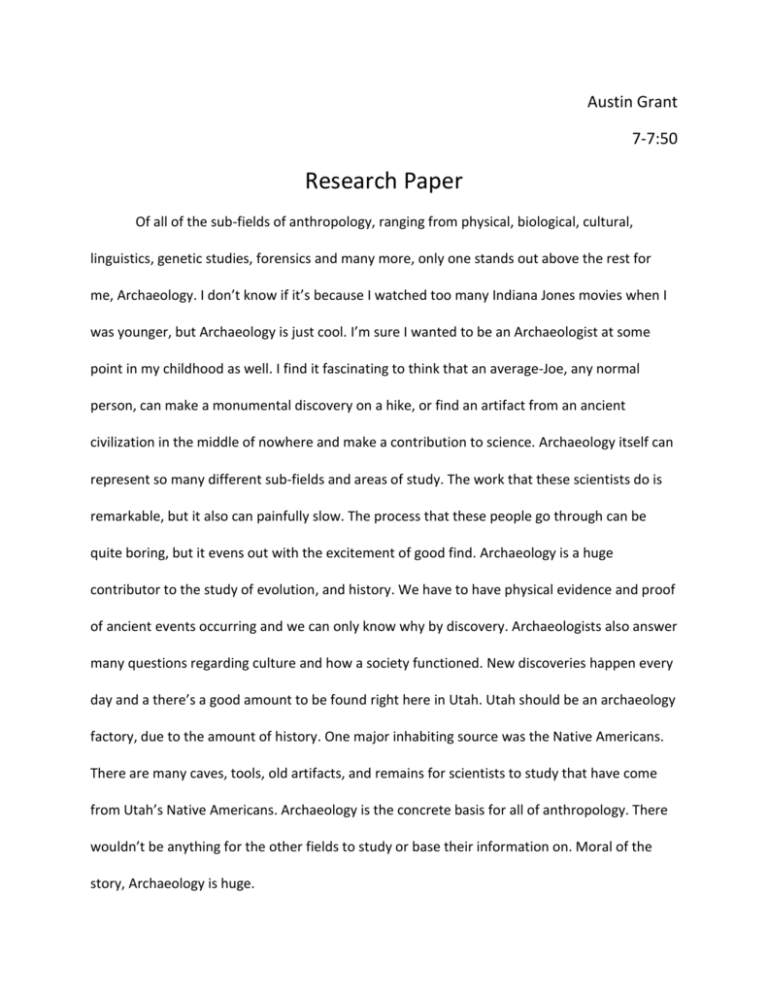
Austin Grant 7-7:50 Research Paper Of all of the sub-fields of anthropology, ranging from physical, biological, cultural, linguistics, genetic studies, forensics and many more, only one stands out above the rest for me, Archaeology. I don’t know if it’s because I watched too many Indiana Jones movies when I was younger, but Archaeology is just cool. I’m sure I wanted to be an Archaeologist at some point in my childhood as well. I find it fascinating to think that an average-Joe, any normal person, can make a monumental discovery on a hike, or find an artifact from an ancient civilization in the middle of nowhere and make a contribution to science. Archaeology itself can represent so many different sub-fields and areas of study. The work that these scientists do is remarkable, but it also can painfully slow. The process that these people go through can be quite boring, but it evens out with the excitement of good find. Archaeology is a huge contributor to the study of evolution, and history. We have to have physical evidence and proof of ancient events occurring and we can only know why by discovery. Archaeologists also answer many questions regarding culture and how a society functioned. New discoveries happen every day and a there’s a good amount to be found right here in Utah. Utah should be an archaeology factory, due to the amount of history. One major inhabiting source was the Native Americans. There are many caves, tools, old artifacts, and remains for scientists to study that have come from Utah’s Native Americans. Archaeology is the concrete basis for all of anthropology. There wouldn’t be anything for the other fields to study or base their information on. Moral of the story, Archaeology is huge. Archaeology is described as the study of earlier cultures, material remains, artifacts, structures, and art. Anthropology mostly covers cultures. The work of an Archaeologist is much more different than I originally thought. I often got them mixed up with Paleontologists, thinking that they find dinosaur fossils. If they do look at the remains of a dead animal, it’s mostly to see how it affected the society’s food source. They often look at soil contents and carbon date them to figure out the soil’s age. Often, they take discoveries and make reports about them, sharing their information and collaborating with other fields of Anthropology. When investigating a site, Archaeologists will usually follow this order, researching the site, surveying any previous works done in the area and what areas could be further researched, the excavation of the site, processing the artifact, analysis, writing a report of the find, and of course preserving the artifacts. I’m very interested in Roman culture and the Roman era in general. A recent archaeological find, rated in the top ten discoveries of 2012 by science daily, that I love is the remains of a Roman military camp that German Archaeologists found in southwestern Germany. They first found stones that looked to be the paved road that led to the front gate. Further evidence ensures that it is indeed a military camp. On one particular stone they found a bunch of tiny holes in it, they believe the holes to be from sandals of the soldiers. It was thought to house soldiers that were on the move and it reached a total of 65 acres. Pottery shards date the camp to the 50’s b.c. This time frame fits perfectly with Julius Caesars notes on what he calls The Gallic Wars. All of this evidence is starting to fit perfectly with history as we know it now, no contradictions. The time frame fits, the location fits with where the Romans were trying to get to, Northern Germany, it all makes sense with Rome’s motivation at the time. This one archaeological discovery has shown not only that there was a military camp, but it says a lot about the Romans and how they constructed buildings, navigated armies, strategies from the generals, how the soldiers lived and socialized while at these camps. It truly is incredible what these German scientists have discovered, and now their find will be incorporated with other bits of history and will be taught the younger generations. That’s the goal of Anthropology, to find out who we are, where we came from, and how we got there. Archaeology isn’t only happening on these far ends of the world, in places where we can’t see or do anything about it, it’s also happening right here in our backyard, Utah. The early settlers of Utah are the most intriguing and in particular, I mean the Native Americans. There has been a recent hot spot for Archaeologists in East Carbon City. Here on a ranch, stone pit houses, granaries, and a bounty of artifacts kept secret for more than a half-century have been found. This site, offers the best evidence of the Fremont culture. They were hunters, gatherers, and farmers in early Utah. A very lovely way to obtain information for Archaeologists is through art. In Carbon City, hundreds of art panels stretch across the land. Specific tools used for crushing grain and corn were found, which also gives an insight to their diet. The location of their food sources also clues the scientists that the Fremont’s moved seasonally and even left behind stores of food to return to. I found out that when a specific sacred item that belongs to a Native American tribe is found, it is returned to them, where as other artifacts that are found are usually taken to a museum or college. There are over two hundred sites so far on the Carbon City ranch and they are only scratching the surface. Archaeology is the most basic and most beneficial of all fields of Anthropology. It is where artifacts and remains are first discovered, analyzed, surveyed, documented, and published for other scientists to contribute. There has to be something physical to start from, and Archaeology is where that happens. I love history, history is my favorite subject and there wouldn’t be any history if it wasn’t for Archaeology. I only wonder what future beings will be examining from us. I would guess our cell phones or I pods. “We do not follow maps to buried treasure and X never, ever marks the spot.” -Indiana Jones



